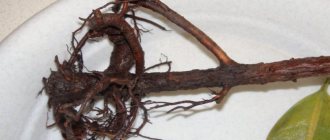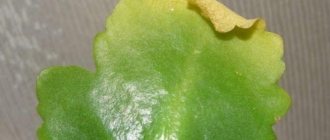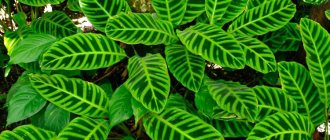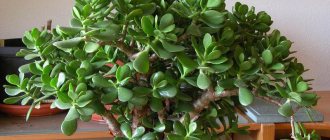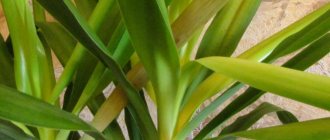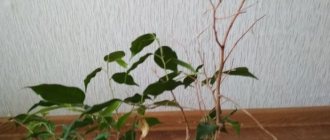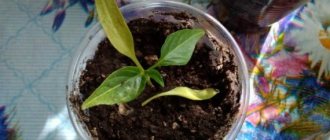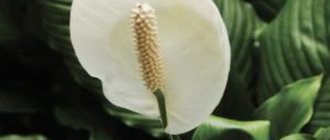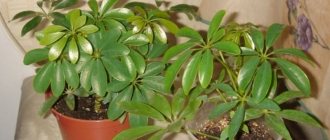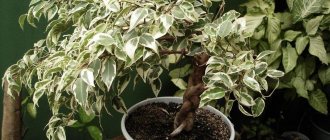One of the most popular indoor plants, ficus benjamina, has become so familiar that the plant is perceived by most gardeners as completely problem-free. But when buying a ficus as reliable and requiring almost no care, we often encounter considerable disappointment. After all, in fact, it cannot be classified as a particularly resistant indoor plant. It is unpretentious, suitable for beginners, but does not forgive big mistakes in care. And not only is it not happy with its growth, but it also drops leaves en masse in case of any problem. Fortunately, if errors are quickly corrected, Benjamin's ficus recovers quickly.
Why do ficus benjamina leaves fall?
Our favorite small-leaved ficus needs no introduction. Its evergreen leaves with a pointed tip are from 2 to 12 cm long, strong trunks with brown bark, thin, most often hanging branches and rich dark green colors are well known to everyone.
Ficus benjamina is very diverse. There are varieties with smaller and larger, unusual and variegated leaves, decorated with borders or spots of white, cream and yellow. But it is no coincidence that all of them are considered the most suitable for apartments, urban environments, rooms of any size, universal interior decoration that can delight for decades.
This type of ficus is indeed enviably unpretentious and hardy, but not invulnerable. He will easily forgive small mistakes and short-term problems, but serious mistakes cause him to have a rather sharp negative reaction. Since Ficus Benjamin reacts to almost all difficulties by dropping leaves, you need to carefully analyze the care and growing conditions in order to find differences from the standard required for the plant. And take a closer look at additional signs.
Let's try to figure out why Benjamin's ficus sheds its leaves? How to cope with its exposure, restore the splendor of the crown and save your favorite evergreen plant?
Reason #2. Lack of light
The ability of Ficus Benjamin to tolerate shading is determined by the variety: green-leaved ficuses are quite hardy and can withstand slight shading, while variegated ones will not retain their color if there is a lack of light. But even the most persistent ficuses, accustomed from a young age to secluded lighting, will not be able to take root only in artificial lighting and in the back of rooms. The maximum shading they can withstand is light partial shade.
Ficuses are especially sensitive to insufficient lighting in winter, when plants need to be moved closer to windows. Before the partial shedding of leaves begins, the ficuses stretch out, become smaller, and lose color, but if the first signals were ignored, damage to the leaf mass will not occur.
How to fix the problem:
- move the ficus closer to the window;
- move to a brighter room with windows facing south;
- organize additional lighting.
Benjamin's ficuses really don't like hot and dry air from heating appliances. © Maja Dumat
Reasons for dropping leaves
Ficus Benjamina sheds its leaves for several reasons. They often fall off due to plant physiology. It is not difficult to distinguish this - if partial shedding of the lower leaves is observed in autumn or winter, then this is the norm. But what to do when leaf fall occurs at other times of the year, and there are really a lot of fallen leaves? This can be caused by improper watering or lack of light. Leaves sometimes turn yellow and fall off when the culture’s usual conditions of maintenance and care change.
Why is this happening? Ficus does not tolerate sudden changes in temperature or a decrease in the amount of light, or moving to a new place. They advise you to choose a place for it in the house right away and not touch it. Even moving a flower from a warm room to a cool one is fraught with leaf fall. The reason why the leaves turn yellow and fall off may lie in keeping the plant on a cold windowsill, tiled or marble floor. Do not allow the crown to touch the window and overcool the ficus.
Remember that their root system is vulnerable. The optimal growing temperature is 18 - 25 degrees. Variegated varieties are more thermophilic. If the indicators are excessive, the foliage may well droop.
Why do the leaves still turn yellow, and the plant strives to get rid of them? The cause may be unfavorable external factors - excess light, dry indoor air and soil (relevant for hanging species). If small yellow spots are found along the edges of the foliage, you need to reduce the amount of watering. Sometimes there is an imbalance of important macro- and microelements.
The leaves can grow poorly and eventually fly off if they do not have enough fertilizer. Replanting or fertilizing will help. After replanting, the crop will have enough nutrients in the new soil, so you can do without fertilizing. You should be wary if you notice deformations of the leaf plate, various stains and damage. Why? Often the flower has lost its leaves, in this case it is caused by fungal infections or the presence of parasites. Treatment with special chemicals will help.
Reason #3. Proximity of radiators and operation of air conditioners
Benjamin ficuses, especially variegated varieties, can quickly lose leaves in mid-autumn, even with ideal care. They really don’t like the hot and dry air from heating appliances; placing ficuses near radiators and fireplaces is not the best idea. And the older the plant, the more sharply it reacts to the beginning of the heating season.
Air conditioners are also often an unfavorable factor for ficus plants: a constant flow of air that differs from the usual and stable temperature can be perceived by the plant as too much stress.
How to fix the problem:
- While the heating systems are operating, move the ficus to a new location or protect it with a screen from the air flow of the batteries;
- increase air humidity by frequent spraying, installing trays with wet pebbles or hanging the battery with a damp cloth;
- move away from the air conditioner.
Why do ficus benjamina leaves fall?
What problem does your ficus have?
Drops leaves
22.66%
Leaves turn yellow and fall off
68.19%
Ficus is completely bald
9.15%
Ficus benjamina is a resident of the humid tropics. It can be forced to shed its vegetative organs:
- natural aging;
- incorrect location of the flower;
- maintenance and care errors;
- pests or diseases.
Benjamin varieties have the smallest leaf blades; they will be shed when Elastica, Binnendijka, Lyre-shaped species feel only slight discomfort.
in winter
Most often, leaves begin to fall off during the dormant period. This time is the most unfavorable for the plant; it requires increased attention and careful handling.
Physiological reasons
If the ficus does not look unhealthy and only sheds the lower or skeletal branches of the plates at the base, this is most likely a natural process.
Each leaf, even under the most favorable conditions, lives no more than 3 years, and then flies around. This usually happens during a period of relative rest.
In winter, an adult ficus benjamina can shed 10-20% of the crown, but with the start of sap flow it will quickly restore it. There is no reason to worry, nothing needs to be done. It should cause alarm if a young plant begins to lose leaves, especially at once and a lot.
Stress
All ficuses, especially those belonging to the Benjamin species, do not like changes. Leaf fall causes:
- adaptation to a new place after purchase;
- normal permutation;
- if the tree is sharply turned with the other side towards a light source located on the side.
Temperature violation
With the start of the heating season, ficus trees feel uncomfortable. And they react to changing conditions by falling leaves, and may even go completely bald.
In winter, ficus leaves often turn yellow and fall off because of this. It is better to check the reason first. Cold conditions coupled with waterlogging are especially dangerous.
During the dormant period, the temperature should be lower than in summer - 15-19 ° C. The minimum that a ficus species of Benjamin can tolerate is 12 ° C. If the foliage is drooping, looks lethargic, or begins to curl, the temperature in the room should be urgently raised. It is unlikely that it will be possible to bring a plant back to life, even if it has stood in the cold for a short time.
It is necessary to control not only the temperature of the air, but also the soil. In winter, they can differ significantly, especially for flowers standing on windowsills. And with any changes, the owners risk being left with a bare plant.
You cannot place the pot close to heating devices - the ficus will shed its leaves due to the heat. When placed close to the window glass, the branches pressed against it will be exposed.
Lack of light
Ficus Benjamin, except for variegated varieties, is not too demanding on lighting. But in winter the sun is not enough for him either.
You cannot place a flower on a bright, southern windowsill, even if the air temperature in the house is comfortable. First, it will shed the plates pressed against the cold glass, then the roots in the pot will freeze, wither, and the remaining vegetative organs will begin to fall off.
The only way to maintain an attractive appearance and prevent exposed branches is with additional lighting. You need to do it 10-12 hours a day.
Dry air
When there is insufficient moisture, Ficus benjamina drops its leaves and turns yellow. In winter it is especially dry due to heating devices. To prevent evaporation, the plant first sheds its leaves. Ficus benjamina should be sprayed no less often than in summer, and more often when the temperature in the room is high.
If nothing is done, thin branches will gradually dry out. As an extreme case, at temperatures exceeding 25° C, damage can even affect the trunk.
Drafts
Ficus generally does not like drafts, and in winter the air is also cold. A tree standing under a window, even after one airing, often completely sheds its leaves.
Care errors
In winter, ficus trees suffer due to improper watering. They shed their leaves from both excess and lack of moisture.
Often, “advanced” gardeners, in order to ensure a dormant period, begin to rarely water the plant at high room temperatures. As a result, the soil in the pot dries out, the leaves first turn yellow, and then the ficus drops them.
If you pay attention to the problem too late, it is not always possible to revive the tree - the root suffers greatly from drying out. It is easier to revive flowers in summer or spring, but in winter the growth processes are suspended, and rescue measures may not lead to success.
You can’t overwater Ficus Benjamin either. After the end of the growing season, it consumes less moisture, the soil in the pot may turn sour, and the root may rot. The plant is highly likely to die.
The lower the temperature, the less frequently the ficus should be watered. If the room is warm, the substrate should not dry out. You only need to use warm, settled water.
In autumn or winter, there should not even be any talk about replanting or excessive feeding. This will not only cause the leaves to fall off, but the ficus may not recover from such treatment.
in spring
With the beginning of the growing season, the ficus begins to grow leaves that have fallen off in winter due to dry air, too warm or cold conditions. But he continues to throw off the plates for the same reasons:
- low humidity;
- heat;
- too rare or frequent watering;
- drafts - air conditioning and fans are added to ventilation.
As the weather warms up, the plant will have other reasons to shed its leaves. In order for the ficus to remain beautiful, you need to know them and prevent them.
Transfer
Even if the ficus is transplanted correctly, the plant will become stressed and shed some of its leaves. There is no need to save it - new ones will appear soon.
To grow a healthy plant, the pot should not be too cramped - there the root takes up almost all the free space, there is always a lack of nutrition and moisture. In a large container you will have to deal with soil soaking, the bush will be lethargic, grow poorly, and drop leaves.
Feeding
Excess and insufficient amounts of nutrients in equal measure cause the plant to shed its leaves. You should use only fertilizers for decorative leafy crops, and even better - specialized ones. Fertilizers for ficus should be used strictly according to the instructions. The concentration cannot be exceeded.
When we talk about alternating mineral and organic fertilizers, we mean ready-made preparations sold in specialized stores.
An infusion of mullein or bird droppings is good in the garden. It is not recommended to feed potted crops with them. Even one watering with homemade organic matter can lead to diseases or pests.
Bright sun
In spring or summer, ficus can get sunburn, especially when standing close to a window. The exception is the variegated varieties of Benjamin. The larger the area occupied by white spots or borders on the plates, the more intense the lighting should be.
The ideal place for the pot is next to the window, not on the windowsill. When the leaves are completely green, in direct sun the Benjamin ficus will shed them.
Trimming
If you make a cut close to a bud, the plate on it, and then the branch to the next node, will dry out. I'll have to cut them off too.
Leaf fall can cause the removal of several thick skeletal branches at the same time on a ring in an adult tree. Rejuvenating pruning or shaping of an old plant should be done gradually.
Incorrect placement on the street
When it gets warm, Benjamin's ficuses are often taken out onto the balcony or into the yard. They will shed leaves:
- when placed in the scorching sun;
- under gusts of wind;
- when pots are not removed from the street during cold weather;
- from differences in day and night temperatures;
- because of the flood in the rain.
If the pot is going to be placed outside, you should carefully choose the location. And protect the plant from unfavorable factors. In any case, it still resets a certain number of plates due to rearrangement.
Reason #4. Unstable temperatures, hypothermia and heat
The ideal temperature for Ficus Benjamin remains a stable, soft and almost unchanged environment in cool living rooms - from 16 to 21 degrees. They adapt quite well to elevated temperatures, but do not like extremes.
Hypothermia, too large changes, temperature rises above 23 degrees make the plant more sensitive to failures in care and air humidity. This is why ficuses often suffer in kitchens, where they are exposed to too frequent temperature changes and overheating. And if you make other mistakes, the ficus may shed its leaves.
How to fix the problem:
- move the ficus to rooms with a stable temperature;
- increase air humidity in the heat and place the plant on substrates or stands in cold rooms;
- Avoid mistakes in watering.
Ficus benjamina leaves fall and branches dry out. How to save ficus
How to revive a ficus that has begun to rapidly lose leaves? This process begins due to many reasons: a sudden change of location, draft, cold and errors in care, or even lack of care. With a regular lack of lighting, too dry air or waterlogging, “leaf fall” and rapid death of the plant will not take long, so measures should be taken immediately.
If the leaves fall off in large quantities, the first step is to spray the Benjamin ficus with the maintenance drug Epin. Restoring the viability of a plant directly depends on the reasons that caused its disease. Sometimes it is possible to restore the beauty and healthy appearance of a rubber plant with the help of basic measures, without even resorting to scrupulous replanting and lengthy processing.
The main conditions for the normal life of a tree are diffused light, moderate and timely watering, air humidity from 50 to 70 percent and spraying. The soil should dry out a little between water procedures, and the need for watering can be easily determined by checking the condition of the soil in the pot. If its top layer has dried out a little (by two to three centimeters), it’s time to water the ficus. You cannot frequently move the pot from place to place, as this will cause leaf fall to become regular, and it may happen that the plant completely loses its foliage, without even suffering from fungal diseases.
The scorching sun is contraindicated for ficus plants. It would be a mistake to believe that if we are talking about a tropical plant, then it will not care about sunlight. The foliage of most rubber plants is dense and thick, which means it contains a sufficient amount of moisture (which cannot be said about tenacious cacti) and will suffer from its lack.
If a gardener gets a tree with a classic, dark green foliage color, such varieties are more unpretentious in care and can acclimatize well even under conditions of regular shading. As for bright variegated leaves, the situation with them is much more complicated: they are capricious, and if the owner does not pay special attention to them, they can quickly die. Variegated varieties are especially sensitive to lack of lighting: they can wither even if they are placed in the shade for a short time.
Air temperature is no less important. In summer, its optimal values are from +25 to 30C, and if it rises, the plant should not only be watered and shaded, but also sprayed. Heat can also cause leaf drying and subsequent rubber disease. In the cold season, the roots should not be allowed to overcool. If possible, it is better to place the pot on a stand or windowsill, wrapping it in a warm cloth. The room temperature should not be allowed to drop below +15C.
So, the issue of resuscitating a fading pet can be resolved by following the usual and simple measures to care for it, as well as choosing a permanent and most suitable growing location, with diffused light and the absence of drafts.
Reason #5. Too long droughts
Ficus benjamina can forgive several missed waterings and short-term drying out of the soil. But if the problems are repeated constantly, the plant is left with a completely dry substrate for several days, the ficus will inevitably begin to shed its leaves.
How to fix the problem:
- use automatic watering systems;
- monitor the degree of drying of the soil, preventing it from drying out completely;
- Water your plants more regularly and delegate watering to friends while you’re away.
With a completely dry substrate, Benjamin's ficus will inevitably begin to shed its leaves.
Reason #6. Water stagnation and root rotting
Despite their moisture-loving nature and the need for fairly intensive watering in summer, ficus trees do not tolerate dampness. As a result of overwatering, the leaves droop and quickly fall off. Water should not remain in the pan, even in summer, for longer than 5 minutes, because even short-term stagnation of water in the lower part of the substrate leads to the beginning of root rotting. Even in summer, it is better not to overdo it with watering, but in winter it is necessary to reduce it, using less and less water in the fall and watering less frequently.
How to fix the problem:
- check how the soil is drying by touch or using indicators, allowing 3-5 cm of the substrate to dry at the top;
- drain water from trays immediately;
- install automatic watering systems.
Reason #7. Soil depletion
Benjamin's ficuses grow actively and intensively; in spring and summer they not only consume a lot of water, but also need constantly high nutritional value of the soil. Without fertilizers, substrate resources are quickly depleted, the plant stops growing, becomes deformed, quickly sheds old leaves and is reluctant to grow new ones.
How to fix the problem:
- fertilize in spring and summer once every 2 weeks, if growth continues, then in autumn and winter with a frequency of once every 6 weeks;
- Follow the dosage indicated on the package.
Preventive measures: what to do to prevent leaves from falling
Carefully care for your Ficus Benjamin so that you don’t have to wonder later why the leaves are falling and what to do. The appearance and health of the flower depends on proper care.
- Place the pot with ficus away from windows and balconies: due to drafts, the plant may begin to shed its leaves.
- Reduce winter watering if the room temperature is less than 10 degrees Celsius.
- Maintain a temperature of 20-25 degrees in spring and summer, 16 in winter.
- Refresh the foliage regularly by spraying or wiping it with a damp sponge.
- Place the flower pot in a place with sufficient lighting, away from direct sunlight. The best option is the eastern side of the house.
- Replant a young plant annually, an adult plant every few years.
- Before watering, loosen the soil so that the moisture is evenly distributed over the ground.
- Use only a high-quality mixture enriched with nutrients to grow a flower. Apply fertilizer as needed.
Why else can ficus benjamina leaves fall?
Ficus benjamina leaves sometimes dry out, turn yellow and fall off due to a rotten root system. Remove the ficus from the flowerpot to test this assumption. If the roots resemble slippery gray threads, trim them. Also remove dried and dead roots.
Soak the root system in a solution of potassium permanganate, then wait until the cut dries and coat it with charcoal powder, foundation or ground cinnamon. Replant the ficus benjamina in new soil and water it sparingly for the first few days.
We hope our article helped you understand why ficus benjamina leaves dry out and fall off and what to do about it. All a house plant needs is care and careful care, and then it will delight your eyes with its healthy, attractive appearance for a long time.
The iPlants team offers a full range of landscaping and comprehensive plant care services:
You can order plant care services, flowerpots with self-watering Lechuza, any plants by calling: (vel) (vel) +375(029) 171 94 42; (mts) +375(029) 503 80 17, and we will also provide the necessary advice. Contact us !
Leave a request or you can here
Reason #8. Imbalance of substances
Ficus plants are decorative deciduous plants that require a special ratio of microelements. Their needs can only be met by complex-component fertilizers with a slightly higher proportion of nitrogen and all microelements (iron, molybdenum, copper, manganese, calcium, zinc).
How to fix the problem:
- choose special fertilizers for ficus trees or at least decorative deciduous plants;
- do not experiment with homemade fertilizers and organics with untested characteristics;
- use fertilizers strictly according to the instructions, without increasing the frequency or concentration.
The needs of ficus benjamina can only be satisfied by complex-component fertilizers
Prevention of yellowing and falling leaves
In order for the plant to fully grow and develop, you need to follow the simple requirements for growing indoor crops:
- the air temperature in the spring-summer period should be between 20 - 25 degrees, and in the autumn-winter period 18 - 20 degrees;
- the flower pot should be placed away from drafts - this may cause leaves to fall off;
- reduce watering in winter, and when the air temperature in the room drops to 10 degrees, stop it altogether;
- choose the right place for the plant, it should be sufficiently lit, but without direct sunlight;
- It is best to place the ficus on the east window;
- regularly spray leaves and remove dust;
- periodically before watering, loosen the soil so that the water does not stagnate and the earthen ball is moistened evenly;
- use high-quality soil mixture;
- Apply fertilizers as necessary, observing the regime of activity and rest.
A lush crown of rich green color appears on ficus when the plant is sprayed with fertilizers diluted in water. To do this, they use both complex additives specifically for ficuses and universal additives for indoor plants. It is important to follow the recommendations indicated on the packaging to avoid burns and excess fertilizer.
Ficus benjamina is not only a beautiful indoor plant, it is a natural filter and can purify indoor air from harmful substances. Proper care and timely treatment of emerging problems is the key to a long and favorable plant life.
Reason #9. Diseases and pests
With good care and in the right conditions, Benjamin's ficus rarely gets sick. But in the heat, with very dry air, lack of basic hygiene, proximity to infected plants, constant problems with watering and improper feeding, even this ficus will suffer from diseases and pests.
Ficus Benjamin is affected by:
- scale insects;
- thrips;
- mealybugs;
- spider mites;
- leaf spots;
- rot;
- sooty fungus.
And the fight against infection is always the same. The plant must be isolated, thoroughly washed with soapy water, and the causes that led to infection must be eliminated (care must be adjusted).
It is impossible to do without treatment with special means. When dealing with pests on Ficus Benjamin, it is better not to delay using insecticides (systemic drugs, for example, Actellik or Karbofos). When affected by rot and spots, plants are treated with systemic fungicides.
Why ficus sheds leaves and what to do about it
The reasons for dropping leaves can be different: improper care of the plant, diseases and pests, as well as natural causes.
Natural causes
Normally, ficus falls off during the cold season, that is, in late autumn or winter. In this case, the plant gradually loses a small number of leaves, which soon renew. This condition is natural and should not cause concern.
Did you know? Ficus benjamina in its natural habitat can reach a height of up to 30 m.
Improper care
Most often, the reason why a bush's leaves fall is due to improper care.
Insufficient lighting level
Like any plant, a flower needs ultraviolet light to ensure vital processes, so it must be kept in a well-lit place, but without direct sunlight.
Important! The sun's rays can cause leaf burns.
Temperature violation
Sudden changes in temperature cause changes in the color of the foliage (it loses its brightness), and then lead to its fall, so you should maintain a moderately optimal temperature in the room, periodically humidifying the air.
Drafts
It is best to place the plant in a place isolated from drafts and cold air currents. Since violation of these conditions will lead to disease and loss of green cover.
Violation of watering and fertilizing regimes
Abundant watering will invariably lead to the death of the flower, as the root part subsequently rots. With insufficient watering, the roots dry out, which leads to leaf fall. It is best to regulate watering depending on the time of year: increase in summer and reduce in winter. Just observing the watering regime is not enough.
It is also necessary to apply fertilizers correctly. As a rule, fertilization is carried out with ready-made mixtures (“Mr. Ficus Flower”, “Palma”, “Rainbow”) 2 times a month in spring and summer. In winter it is not necessary to do this, or reduce the amount of feeding to once every 2 months.
Important! Ficus Benjamin should be watered and sprayed only with settled water. Give the ficus a shower once a month, covering the soil and pot with film.
Incorrect location
Frequent changes of location or poor placement of the pot lead to Benjamin's ficus losing its appearance and becoming ill. When choosing a location for a flowerpot, you need to take into account the fact that in winter the plant should be away from heat sources that dry out the air.
In summer, the plant needs to be provided with fresh air, absence of direct sun and drafts. It is not advisable to move a pot of ficus from one place to another.
There are several varieties of Ficus benjamina, including Ficus kinki and small-leaved Ficus.
Diseases and pests
Diseases and insects are common causes of plant loss of leaves. In order to carry out treatment in time and save the flower, you need to correctly determine the source of the disease - a fungus or pests.
The main pests include:
- scale insect. It is attached to the bottom of the leaf and looks like a brown scaly tubercle. A sooty fungus appears on her secretions. It is destroyed by wiping the affected leaves with a soap solution and spraying the entire plant with an insecticide (Aktellik, Aktara, Bankol). In case of a large lesion, the infected areas are cut off;
- spider mite. Symptoms of spider mite infestation include the formation of thin webs on the crown and the appearance of marbled spots on the foliage. It is necessary to wash the plant with a soapy solution, and in case of severe infection, treat it with the insectoacaricide “Aktellik”;
- mealybug. This is a small white insect that forms cotton wool when gathered in groups. It must be dealt with mechanically - by washing with soapy water. In a neglected state, treat with a special pest control agent - Actellik insectoacaricide.
- aphid. It is easy to detect on the underside of the leaf. She lives in large groups. It can be removed by wiping with a solution of laundry soap.
Fungal diseases are no less dangerous:
- cercospora - affects the lower part of the leaves in the form of growing brown or black dots. It is treated by removing the damaged areas or spraying with antifungal drugs (“Alirin-B”);
- anthracnose is a fungal disease characterized by rusty spots on leaves and stems. Diseased leaves are removed, and the plant is treated with a fungicide (“Alirin-B”);
- gray rot - forms mold on the crown. It is necessary to ventilate the room in which the flowerpot is located more often and spray it with fungicides (Alirin-B, Vectra, Gamair);
- sooty fungus - has the appearance of a gray-black coating. Wash off with soapy water;
- root rot — affects the root part of the flower and is difficult to treat. You can save the ficus by cutting off the diseased roots and replanting it in a new pot. After trimming the diseased part of the roots, the cut site should be treated with activated carbon tablets or charcoal. At the same time, reduce the amount of watering so that the plant recovers from the disease.
Other reasons
Although less common, other reasons can also lead to leaf falling. Ficus benjamina cannot be grown in a dense, airtight substrate without a high drainage layer at the bottom of the pots. The plant reacts painfully to too frequent replanting (if the roots were not allowed to fill the entire space of the previous container), failure to replace the top layer of soil in years without replanting, complete removal of the substrate and washing of the roots (except in cases of rot damage).
One should not blame the loss of leaves on the lack of pruning: it can be done in the spring, forming a crown, but the plant can be grown just as successfully without it.
